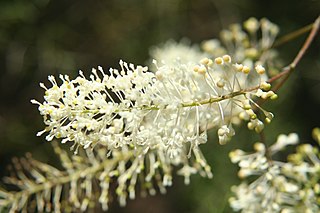
Grevillea leptopoda is a species of flowering plant in the family Proteaceae and is endemic to the south-west of Western Australia. It is a spreading to erect shrub with divided leaves, the lobes further divided, the end lobes linear, and clusters of white to cream-coloured flowers.

Grevillea triloba is species of flowering plant in the family Proteaceae and is endemic to near Geraldton in Western Australia. It is a diffuse or spreading shrub, usually with divided leaves with 3 spreading, linear lobes, and clusters of white flowers.
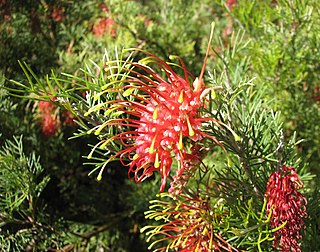
Grevillea thelemanniana, commonly known as spider net grevillea, is species of flowering plant in the family Proteaceae and is endemic to Perth, Western Australia. It is a spreading shrub with linear and pinnatipartite to pinnatisect leaves with linear to narrowly elliptic lobes, and clusters of 6 to 14 pinkish-red and cream-coloured flowers with a red, green-tipped style.

Grevillea humifusa, commonly known as spreading grevillea, is a species of flowering plant in the family Proteaceae and is endemic to a restricted area of the south-west of Western Australia. It is a prostrate shrub with long, trailing stems, divided lives with linear lobes and clusters of pink to pale red and cream-coloured flowers with a reddish, yellow-tipped style.
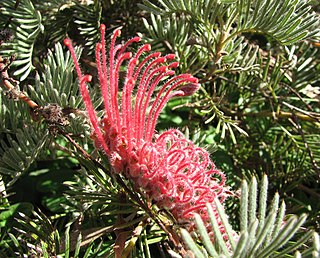
Grevillea thyrsoides is a species of flowering plant in the family Proteaceae, and is endemic to the southwest of Western Australia. It is a small, spreading or low-lying shrub, with pinnatisect to comb-like leaves, the end lobes linear, and clusters of hairy pinkish-red flowers.
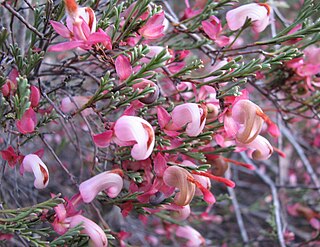
Grevillea involucrata, also known as Lake Varley grevillea, is a species of flowering plant in the family Proteaceae and is endemic to the south-west of Western Australia. It is an openly-branched, prostrate or low-lying shrub with divided leaves with parallel, oblong to linear lobes, and pink flowers with a pinkish-red style.
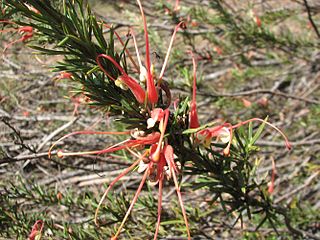
Grevillea tripartita is species of flowering plant in the family Proteaceae and is endemic to the south-west of Western Australia. It is an erect, prickly shrub with divided leaves with 3 lobes, and clusters of red and cream-coloured or reddish-orange and yellow flowers.
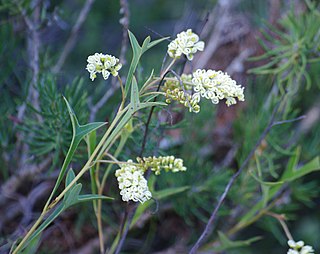
Grevillea synapheae, commonly known as catkin grevillea, is species of flowering plant in the family Proteaceae and is endemic to the southwest of Western Australia. It is a prostrate to erect shrub usually with divided leaves with 3 to 7 triangular to more or less linear lobes, and clusters of white to creamy yellow flowers.

Grevillea huegelii, commonly known as comb spider-flower or comb grevillea, is a species of flowering plant in the family Proteaceae and is endemic to southern continental Australia. It is an erect to low-lying shrub with divided leaves with mostly three to eleven sharply-pointed linear lobes, and clusters of red to pink flowers that are silky-hairy on the outside.

Grevillea plurijuga is a species of flowering plant in the family Proteaceae and is endemic to southern Western Australia. It is a prostrate to low-lying or dense mounded to erect shrub with divided leaves with linear lobes and loose clusters of hairy, red or pink flowers.

Grevillea nana, commonly known as dwarf grevillea, is a species of flowering plant in the family Proteaceae and is endemic to the south-west of Western Australia. It is a prostrate to low, mounded, dense shrub with divided leaves with sharply-pointed, linear lobes, and clusters of pink, orange, yellow or red flowers.
Grevillea lullfitzii is a species of flowering plant in the family Proteaceae and is endemic to a relatively small area of inland Western Australia. It is a spreading shrub with deeply divided leaves, the lobes linear and sharply-pointed, and clusters of greyish-white and cream flowers with an off-white style.

Grevillea hirtella is a species of flowering plant in the family Proteaceae and is endemic to the west of Western Australia. It is a spreading shrub with crowded linear and divided leaves and clusters of pale pink to deep red flowers.

Grevillea leptobotrys, commonly known as tangled grevillea, is a species of flowering plant in the family Proteaceae and is endemic to the south-west of Western Australia. It is a prostrate shrub with simple and toothed, or divided leaves, the lobes further divided, the end lobes triangular, egg-shaped, oblong or more or less linear, and clusters of pale to deep lilac-pink flowers.
Grevillea maherae is a species of flowering plant in the family Proteaceae and is endemic to the Kimberley region of Western Australia. It is a densely-branched shrub with divided leaves with sharply pointed lobes, and clusters of pinkish red to maroon flowers with a red style.
Grevillea metamorpha is a species of flowering plant in the family Proteaceae and is endemic to an area in the Mid West region of Western Australia. It is an erect, spindly shrub with three types of divided leaves, and clusters of white, silky-hairy flowers.
Grevillea nivea is a species of flowering plant in the family Proteaceae and is endemic to the south of Western Australia. It is a dense shrub with spreading to ascending branches, crowded, divided leaves, the end lobes linear, and dense clusters of red flowers.
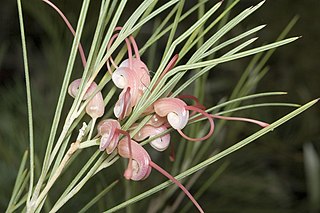
Grevillea oncogyne is a species of flowering plant in the family Proteaceae and is endemic to inland areas of Western Australia. It is an erect to spreading shrub with linear, sometimes lobed leaves, and clusters of red or pinkish red flowers.

Grevillea paradoxa, commonly known as the bottlebrush grevillea, is a species of flowering plant in the family Proteaceae and is endemic to the south-west of Western Australia. It is an erect to spreading, prickly shrub with pinnatipartite leaves, the lobes linear, widely spreading and sharply pointed, and with cylindrical clusters of pale to dark pink or cream-coloured flowers with a pinkish-red style.

Grevillea rara, also known as the rare grevillea, is a species of flowering plant in the family Proteaceae and is endemic to a restricted part of the South West region of Western Australia. It is a prostrate, sprawling shrub when young, later a dense, prickly shrub with pinnatisect leaves with linear lobes, and clusters of white to pale pink flowers.

















